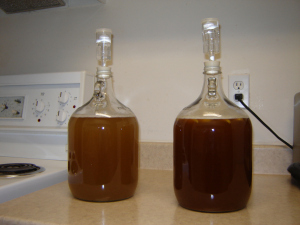Get thee to a mead’ry
Since I have been receiving a lot of encouraging comments from family and friends about my mead, I have continued to pursue this delicious hobby of mine. I really appreciate their kind words, but I do have to take them with a grain of salt and aim to improve the quality of the meads I am producing. So the talk of making this hobby a business making venture appear to me to be somewhat premature, I personally do not think I am anywhere near ready. Each of my batches of mead are wildly different, and I have yet to master the art of converting what I have envisioned in my mind and my taste buds into a mead. Mostly this will involve improving my mead making technique, and the other part will be taste experience.</p>
I can look at this challenge in a positive and negative light, since both aspects involve spending much more time devoted to this craft. On the upside that means I will have to make plenty of mead to get pretty good at it, but on the downside it will just take a long time particularly when it comes to mead since it needs so long for it age properly. I typically age my mead 3 months before I let them bottle age for several more months, but I have heard of other mead makers leaving their mead to age several years! At this stage I don’t have that kind of time, unless I make a huge batch, e.g. 38 L - 57 L (approx. 50 - 75 bottles), I might be able to reserve a few bottles and let them age 2+ years. Though I would still have to continue to make more mead, otherwise I might be tempted to dip into the reserve stock.
Furthermore if I intend to make my mead commercially viable, I need to settle on at least three or four different varieties that I think will sell. At this stage I could only think of one that I would certainly consider selling once I perfect the recipe, so I am on the hunt for new recipes, new spices, different honey and yeasts. So I need to expand my repertoire! Avanti!
These are the next three meads that I prepared:
Alfalfa Apple Cyser
- 4.0 L apple cider
- 1.5 kg Alfalfa honey
- 1 cinnamon stick
- 1 pinch of nutmeg
- 3 whole cloves
- Lavlin EC-1118 yeast
- Yeast nutrien
I combined the ingredients, re-hydrated the yeast, oxgenated the mixture and let the yeasty beasties do their thing. This is my first time making a cyser, so I am anxious to see how it turns out.
Alfalfa Vanilla Bean
- 4.0 L spring water
- 1.5 kg Alfalfa honey
- 2 whole vanilla beans
- Lavlin EC-1118 yeast
- Yeast nutrient
For this mead I combined all the ingredients except the vanilla beans, which I would add later after the fermentation completed. Most flavours are dissipated by the fermentation process, so adding ingredients for flavour after most of the fermenting is done appears to be good practice (especially for vanilla since its flavour is very delicate). To add the vanilla I plan on extracting the flavour from the beans before hand, so essentially making my own vanilla extract. Apparently you don’t want to use the vanilla extract you can buy in the store, since it contains the unpleasant tasting propylene glycol as a preservative. I have been waiting to try this recipe for several months, and I have some high expectations for this mead.
Manuka Ginger
- 4.0 L spring water
- 1.5 kg Manuka honey
- 8 - 10 cm piece of ginger (peeled and sliced)
- Lavlin EC-1118 yeast
- Yeast nutrient
Again I combined the above ingredients and let the yeast get to work. I have tried this mead recipe before, but the last time I make it I wasn’t too impressed with the flavour. I think there were a few off-flavours present, so I hope by paying closer attention to details (sanitation, sanitation, sanitation) I will produce a better product this time.

You will probably notice that I am no longer using the plastic containers from the spring water for this batch, I have come into some nice glass jugs and I purchased some extra air locks to keep all those nasty bacteria out. This appears to be a new stage for me, I really like these glass jugs better than the plastic containers. Though this does mean more work cleaning and sanitizing the glass containers, which I never worried about with the plastic jugs. I may procure a few more so that I can practice at a somewhat faster pace than I am currently, and move towards mastering the dark art of mead making.
One final note, if you are curious about tasting mead you can usually find a few local producers in your area or at your local liquor store. Though if there aren’t any nearby or none available for you to buy, a lot of these meaderies sell their mead online and some can even deliver them to your door! So explore online for some local meaderies, and order a bottle or two. If I am ever going to make this hobby into a viable business, I need a well informed customer base. So get out there and enjoy yourself some mead, who knows in a few years I might have something available for you to purchase!